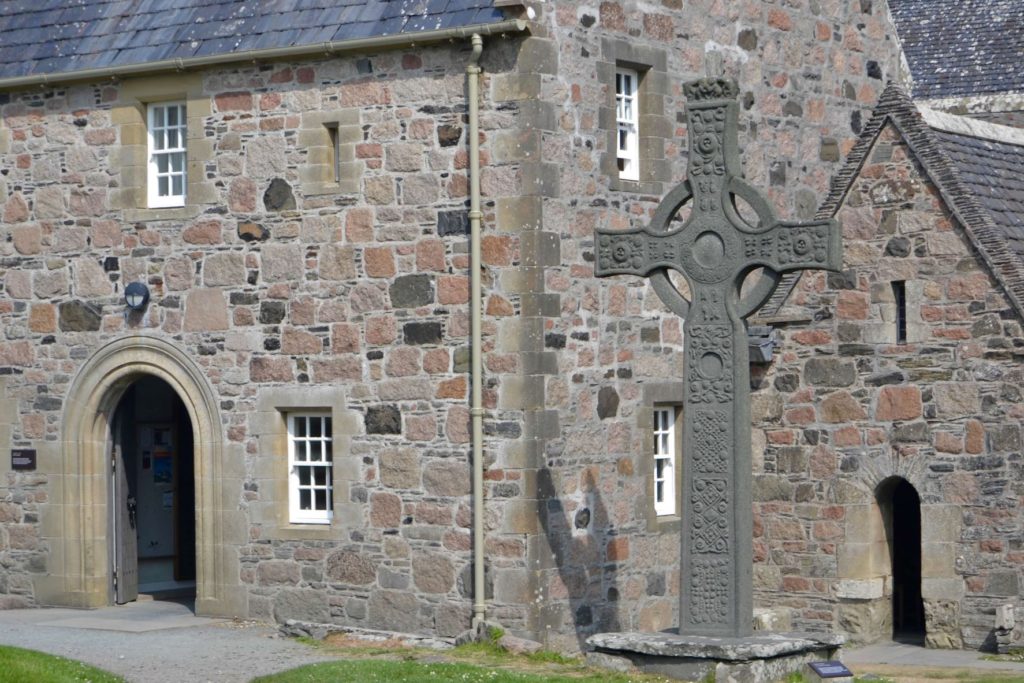Saint Patrick’s Day traditions are all over the place in March. For the most part, I love them. My favorite color is green, and I leave the clover in my yard be(e). While I’m not terribly keen on cabbage unless it’s raw and covered in mayonnaise and called slaw, I do love corned beef and potatoes.
I have fond childhood memories of classrooms decorated in four-leaf clovers and leprechauns. Sometimes a leprechaun would even show up and wreak havoc overnight. I hear these days some leprechauns will go so far as to invade your home, covering everything in green glitter and filling the toilet with green–stuff–which is more than I ever needed to know about a leprechaun’s digestive system!
While I enjoy participating in many Saint Patrick’s Day traditions, parts of the holiday make me squirm. I don’t love the relentless stereotyping of Ireland and Irish culture and people. As I’ve spent more time in Ireland and learned more about its history, I’ve become increasingly queasy about throwing around Irish symbols like the shamrock and the flag and even green and orange, knowing how many people have died over them.
But I’m not here to rain on your Saint Patrick’s Day parade. It’s entirely possible to celebrate in a way that is meaningful and respectful and fun. For me, that means a greater focus on Irish history, including the story of Saint Patrick.
DISCLOSURE: This page may contain affiliate links. This means if you click on a link to a product or service and make a purchase, I may receive a commission at no cost to you. I choose affiliates with care and appreciate your supporting my work in this way. See Disclaimers and Affiliates for more information.
What I Learned About Saint Patrick’s Day Traditions at the Saint Patrick Centre
The town of Downpatrick in County Down, Northern Ireland is a major site of Saint Patrick tourism and pilgrimage. Our family visited The Saint Patrick Centre, an interactive museum devoted to Saint Patrick’s life and legacy, and Down Cathedral, a Church of Ireland by the traditional site of Saint Patrick’s burial.
|Related: Why You Should Add Historic Sites to Your List of Places to Visit with Toddlers
At The Saint Patrick Centre and Down Cathedral, I learned a few things that changed my perspective on common Saint Patrick’s Day traditions.
Read on for three Saint Patrick’s Day traditions I’ll never think of the same way again.

1. The Wearing o’ the…What?
Our guide met us at the entrance of the walk-through exhibit at the Saint Patrick Centre. The first thing she did was point out the color of her uniform fleece pullover: not green but dark blue.
“Why am I not wearing green?” she asked. “Green is not the color traditionally associated with Saint Patrick. The color traditionally associated with Saint Patrick is actually blue.”
I’ve never been pinched for not wearing blue on March 17. It kind of blew (see what I did there?) my mind.
The tradition of wearing green probably arose in the United States and was strengthened by successive waves of Irish immigrants for whom Saint Patrick’s Day became less about the saint and more about celebrating their homeland.
I still wear green on Saint Patrick’s Day–it is my favorite color, after all–but now I also try to mix in a bit of blue in honor of the man himself.
2. Where Exactly Are Those Snakes?
Legend says that Saint Patrick drove them out of Ireland and into the sea. Many naturalists and folklorists and everyday folks have weighed in on what this actually means. It seems verifiable that there aren’t any native snakes in Ireland and haven’t been for quite some geological time (way before Saint Patrick, who lived in the 400s CE), if there ever were,
Everybody’s got a slightly different take on where this legend comes from. It was promoted hundreds of years after Saint Patrick’s death by monks drawing attention to him and his miracles. It seems to have been misinterpreted over the years to mean literal snakes instead of figurative ones.
This misinterpretation thing happens a lot in history.
That’s one reason it’s important to try to view the world through our subject’s eyes and not our own 21st-century ones. Word meanings shift over time, for one thing. For another, we tend to be very literal thinkers, while our pre-Enlightenment ancestors were more figurative.
There probably weren’t any real snakes in Ireland for Saint Patrick to cast out. But I don’t have to tell you which animal has been associated with evil since the Garden of Eden. And those pre-Christian Celtic knot designs sure look serpentine and slithery.
Saint Patrick was all about getting rid of pagans, one way or the other. It’s possible that “driving the snakes out of Ireland” refers to driving paganism out of Ireland, as symbolized by Celtic artwork.

3. The Luck of the Irish?
Spend a little time with Irish history and you’ll realize that maybe you don’t want “the luck of the Irish” because the Irish haven’t always had the best luck over the centuries.
Or so I learned in Downpatrick. According to the guide I talked to, the phrase is meant to be ironic, in the sense that you say one thing but mean another. Someone might tell of their bad luck, and another person might roll their eyes and reply, “That’s the luck of the Irish for you.”
I love self-deprecating humor like this. That origin story makes more sense than the phrase being associated with leprechauns. According to most stories, leprechauns are tricksters and hanging out with them doesn’t often bring good luck.
I now have a little chuckle to myself every time I see a t-shirt or yard sign or mailbox cover claiming to have the luck of the Irish. And I definitely don’t have any decorations asking for the luck of the Irish!

Saint Patrick’s Day Traditions versus History
There are layers of cultural meaning and historical understanding in a topic like Saint Patrick’s Day.
There’s the origin of it all, Saint Patrick himself. Then there’s what later monks wrote about him after his death. Centuries of stories and traditions pile on top of that. Then come the stories about how the stories and traditions came to be, with generations of people putting their own spin on all of it.
What we sometimes think of as cut-and-dried “historical fact” can get pretty dicey. Saint Patrick is a great example of that.
When we’re working with a person who lived in a time and place with little documentary evidence and also with very different notions of “fact” and “truth” from our own, it’s easy to end up with flawed interpretations and to lose a lot in translation.
There’s so much we’ll never know for sure, both about Saint Patrick and about the true origins and meanings of various Saint Patrick’s Day traditions.
In cases like these, it can be more helpful to focus on what we learn about a culture from the stories it tells than to worry about whether the stories (like Saint Patrick driving the snakes out of Ireland) are factually true in the sense that we understand truth in the 21st century.
Share Your Saint Patrick’s Day Traditions
Here’s one thing we can know for sure: Saint Patrick’s importance in Irish history is immense. In fact, 432 CE, the traditional date of Saint Patrick’s arrival, is generally considered the beginning of Irish history. (The island was obviously inhabited before, but that time is considered prehistoric.)
Each year, I like to read about Irish history and legend during the month of March. I give my kids a book as well. Stay tuned for a post highlighting some of our favorites!
I’d love to hear about your favorite Saint Patrick’s Day traditions! Let me know in the comments.
A version of this post appeared on March 14, 2022. This one is updated for 2023.
Pin it for later!

22 comments
Great and thoughtful post on Saint Patrick’s Day. I like the suggestion to focus on Irish history and the story of Saint Patrick. Thank you for sharing!
I’m glad you found it helpful!
I love history so this was a fun read! One day I hope to visit Ireland 🙂
I’m glad you enjoyed it! I hope you get to visit!
Great article! Very informative.
I’m glad you enjoyed it!
I’ve visited Ireland quite a few times and somehow never knew this! Thanks for sharing! It’s great to have some accurate information to share with my daughter as we work out our St. Patrick’s day celebrations.
I’m glad I was able to share something new! Enjoy your celebrations!
This is such a great conversation! I love Ireland, my grandparents were Irish and we spent every summer there but I agree, stereotypes abound. So good too learn something new about St. Patrick’s Day.
Lucky you! Ireland is so beautiful in summer. My daughter made new friends at every playground we visited.
I would love to get a chance to visit the Saint Patrick Centre! I took my mother to Ireland a handful of years ago, and we loved it. I can’t help but love all things related to St. Patrick’s Day as I have Irish ancestors!
It’s well worth a visit! I hope you get to go someday!
I enjoyed this article very much. I never knew there even was a St. Patrick’s grave. Fascinating! The concept of the pagan Celtics having snake symbols and St. Patrick driving those types of snakes out of Ireland, or simply converting them, makes more sense to me than the usual concept of driving out the slithering-on-the-ground snakes. Thank you.
So glad you enjoyed it! Yes, it’s certainly interesting how stories change over time, and how our more literal thinking collides with our ancestors’ more figurative worldview–the snakes are a great example of that.
This is SO interesting! I’m actually part Irish/Scottish on my dads side, so I love learning about the land of my ancestors. It helps me connect to them a lot more. Thank you so much for sharing this!
I’m glad you enjoyed the post!
This was great information. I had no idea about the legend of the snakes. We don’t have any traditions but my kids always enjoy the school activities.
I’m glad you enjoyed it! I always think that the different origin stories of legends are so interesting. Happy St. Patrick’s Day to your family!
Adding “Pale Rider” to my list to read !! I, too, love corned beef, but am the only one in my family that likes it. I say, all for me, then! Happy St. Patrick’s Day from Peoria !🇮🇪
Happy St. Patrick’s Day, Allison! I would fix that corned beef and eat it all myself if I were you! Can’t wait to hear what you think of PALE RIDER. I’m about halfway through.
I’ve always wanted to visit Ireland and wow…I did not know they did not have snakes! I hate snakes so that’s awesome. But, I need to tell my kids the story is likely symbolic because they just came home and told me about it yesterday.
Ireland is a wonderful place to visit. I hope you get to make that trip someday! I’d be curious to hear what your kids think of this view of St. Patrick and the snakes!